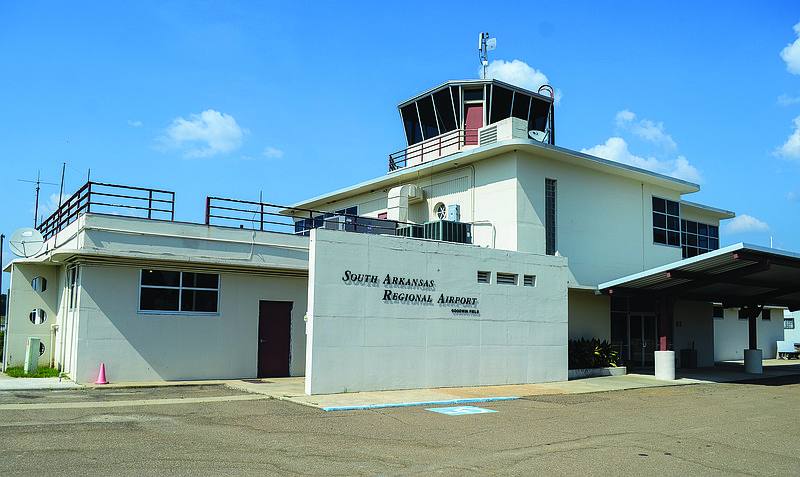Planning is still underway for a renovation/restoration project for the terminal building at South Arkansas Regional Airport at Goodwin Field.
The El Dorado Airport Commission continues to explore potential funding sources to cover the costs of the extensive project.
In the meantime, commissioners have agreed to take the first step in addressing upgrades that are needed for the facility’s HVAC (heating, ventilation and air conditioning) system.
The commission agreed May 10 to hire an engineering firm to study the existing system and determine how best to approach the issue, which could call for a portion of the system to be replaced.
The HVAC system is a part of the master plan to restore/renovate the post-World War II-era terminal building and mechanical engineers would determine if work on the HVAC system could be performed separately from the other components of the project.
Blake Dunn, of CADM Architecture, Inc., told commissioners they could apply for a state grant to potentially cover costs of the HVAC project.
“That’s what this is all about. We’ll get the engineering firm to come and see if it’s a feasible option for us and if it is, we’re going to apply for this grant,” said Mickey Murfee, chairman of the airport commission.
Commissioners and SARA manager Johnathan Estes have said an energy efficiency issue in the terminal building affects the operation of the HVAC system.
“The building lets in a lot of unconditioned, outside air, which makes the HVAC system have to work overtime,” Murfee said.
When the system is turned off, a persistent odor and moisture permeate portions of the terminal building.
Commissioners have also said three existing HVAC units would be removed from the roof on the second floor of the terminal.
The mechanical engineering study would determine if new units could be relocated and placed on the ground.
“Where it would be, that I can’t answer,” Murfee said.
Mechanical engineers will also determine if modern HVAC systems would be a good fit for the airport terminal, Murfee said, noting that the systems were not available when the master renovation was initially drafted in 2015.
“What they would do, as I understand it, is this HVAC system doesn’t require that we redo the duct work, which would be favorable,” he explained. “It gives a lot of independent air and heating in various parts of the building and that is ideal for historic restorations.”
“If we can do the HVAC system separately, we’ll go that route and it will also reduce the overall costs of restoration,” Murfee added.
Dunn has agreed to contact a Little Rock engineering firm that assisted CADM with the initial renovation/restoration plan in 2015.
After reviewing options that were included in the master plan at the time, the airport commission voted to build a new terminal at an estimated cost of $2.1 million, versus a refit of the existing building for an estimated $1.9 million.
Murfee, who was a member of the airport commission then, cast the lone no vote on the motion to rebuild.
A public hearing was held in May of 2016 and airport commissioners heard arguments on both sides of the matter.
Airport Commissioner Aubra Anthony Jr., who was not a member of the commission at the time, was a vocal opponent of tearing down the terminal.
During the public hearing, Anthony provided information that helped set off a chain of events that resulted in a Federal 106 Review — and a potential Section 4(f) process — that ultimately squashed plans for new construction in favor of restoring the existing terminal.
The Section 106 Review and Section 4(f) processes stipulate how the Federal Highway Administration and U.S. Department of Transportation may approve the use of certain property, including public or private historical sites.
The airport terminal has since been added to the National Register of Historic Places and in late 2017, major repairs were done to fix leaks in the roof of the terminal.
A $64,600 grant from the Arkansas Department of Aeronautics covered more than half the cost of the $130,000 project.
The El Dorado Works Board and El Dorado City Council matched the grant with funding from the city’s one-cent sales tax for economic development, municipal infrastructure and quality-of-life projects.
Also in 2017, the master renovation/restoration plan was updated and included a new budget estimate of $2.1 million.
The airport commission subsequently formed an ad-hoc committee to explore funding options and reached out to the Diamond Agency, a local ad agency, for ideas to develop a marketing and promotion campaign to help drum up support for the airport and the renovation.
The SARA terminal administration building was designed by late architect John B. Abbott, one of the founders of CADM Architecture, Inc.
Construction was completed in 1950.
The building contains architectural elements of Moderne and International styles, including smooth exterior walls with minimal ornamentation; flat roofs; rounded edges along the flat projecting eaves; and wraparound windows covering large expanses of the wall planes.
Murfee said there is no rush on the engineering study, though commissioners would like to complete the work within the next 12 months.
Commissioners have also said they will have to tweak the master plan, noting that construction costs have risen since the plan was reworked in 2017.
“We’ll need to go back in a look at what was designed with the original plan seven, eight years ago,” Murfee said.
“We’re still looking at potential funding sources for the restoration project,” he said. “I hope we can get a lot of that done this year. I don’t know if we can but we’re going to try.”
